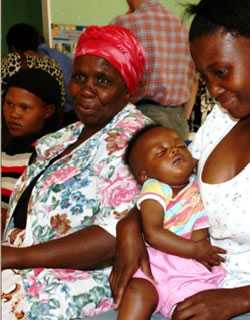University of KwaZulu-Natal: 20,000+
CDC and 20,000+ are integrating TB and HIV programs in the PMTCT program, as TB has been found to be one of the leading causes of maternal deaths in HIV-infected mothers
Prevention of Mother-to-Child HIV Transmission

An evaluation done by the Medical Research Council, the University of the Western Cape, and the US Centers for Disease Control and Prevention found that the national prevention of mother-to-child HIV transmission (PMTCT) program has improved extensively, with the goal of zero new infections by 2015 nearly in reach.
South Africa is celebrated worldwide for their successful reduction of mother-to-child HIV transmission which dropped dramatically from 8.7% in 2008 to 2.7% in 2011. This means that approximately 104,000 babies were saved from mother-to-child HIV infection last year.
Using Data to Improve Services
In 2007 and the University of KwaZulu-Natal was awarded a five-year grant to help achieve the goal of zero new mother-to-child infections through improving data.
The project, led by the University of KwaZulu-Natal’s Dr. Jennifer Reddy used a health system strengthening approach to improve PMTCT data collection and use in several provincial district clinics.
20,000+
The name of the project – 20,000 – is the number of HIV infections from mother to infant that could be prevented each year in KwaZulu-Natal if every mother receives care according to the national PMTCT guidelines. The “plus” (+) in the title refers to the additional children that could be helped if infant feeding practices could be optimized in the communities and so avoid postnatal transmission of HIV through breastfeeding while still promoting child survival (i.e., avoiding deaths from diarrhea and malnutrition due to unsafe infant feeding practices.
20,000+ are integrating TB and HIV programs in the PMTCT program, as TB has been found to be one of the leading causes of maternal deaths in HIV-infected mothers. Although the project primarily focuses on maternal and child health, they are also developing overall skills of information officers in data management. Training has also been held for monitoring and evaluation of programs. Using task- shifting and improving process flow in facilities is contributing to improved efficiency of service delivery within existing resources.
Partnering with the Department of Health

A partnership between the University of KwaZulu-Natal, the Instittue of healthcare Improvement (IHI) and the KwaZulu-Natal Department of Health is using evidence-based and continuous quality improvement methods to strengthen PMTCT services. The partnership uses the District Health Information System DHIS) data, which is routinely collected and submitted by clinics each month.
Clinic staff and district coordinators have learned, through 20,000+ to used data to identify gaps in services, and to propose solutions to closing these gaps through using data. Once the solution is implemented, data is once again examined to establish whether the problem was resolved, and if not, what other steps should be taken to improve the program. During the study, overall data completeness improved from 26% before the intervention at all 222 facilities to 64% after, and the overall accuracy of the remaining data on all six data elements improved from 37% at the first data audit to 65% at the third data audit.
20,000+ has a broader effect than using data through the development of skills in the usage of data and improving monitoring and evaluation of programs, leadership and mentorship skills are improved.
One district health care worker commented. It is wonderful to come to work these days. There are no longer queues of mothers with sick babies. I tested 94 babies in the past three months and no a single one of them was HIV-infected!
For more information please visit www.ukzn.ac.za.
- Page last reviewed: January 14, 2013
- Page last updated: January 14, 2013
- Content source:
Global Health
Notice: Linking to a non-federal site does not constitute an endorsement by HHS, CDC or any of its employees of the sponsors or the information and products presented on the site.


 ShareCompartir
ShareCompartir